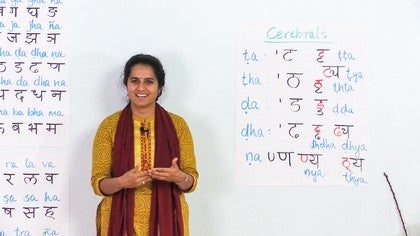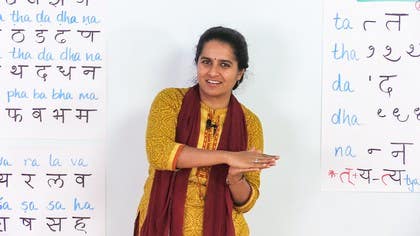Description
About This Video
Transcript
Read Full Transcript
Namaste Priyamitradi my dear friends. I hope you've been practicing the letters till now. In the alphabet we have seen the guttural, the palletils. We've seen how of the five letters in each group look like and how you can step by step write them out. We see that they correspond to the throat, the palate. Now we are at this important set of letters called the cerebrals. I say important because this set of letters or this set of sounds don't belong to the English world, English-speaking world or they don't belong even to those who speak Spanish, French, the whole Latino group does not have these set of sounds and so it's important to pay a little attention to it. Bring your awareness, very consciously place your tip of the tongue on the center of the roof of your mouth. So it's a T. If you want to practice it and make sure you're getting it right just touch the roof of your mouth with your finger, the index finger and then place your tongue there every time you say the different letters. So we have the T, D, D, D, N. You will notice that when we are trying to write it in the Roman script we have a dot below it. So the dot below indicates that the tongue has to go up. So it becomes the T, T, D, D, N. This particular point of touch is very beneficial for the body because as in Qigong they talk of two meridians in the body that flow. The two meridians meet at that point which is the center of the roof of your mouth. So when you are basically doing this group of sounds you're doing T, T, you consciously stimulate that point again and again and you know how good that can feel. So now that we know what these letters sound like let's have a look at what they look like. How do we write them out? What I would do is I will try and write them out stroke by stroke so that you get an idea of how it flows. The usual rule is that it always goes from left to right. Cerebrals. The first letter on this group is the T. The letter T is already a combination of the phoneme T plus the vowel R so T. This one is actually quite an easy one to remember because it looks like a half tomato. You see? It looks like half a tomato. So a little bit with the sounds a T for tomato, half tomato and you'll have it right. T, one, two and you put the line across. The line on the head just helps you to identify each letter individually. So that's the T, say that T. Don't put your tongue in back too much because then it will be the T and you will suffocate yourself. So keep it in the center and do the T. Lovely. The second one is with breath or the Maha Prana. You add an extra breath on it and that is the full tomato as you can see. So we have half a tomato and then the full tomato. One and the full tomato. You put the line on the head. So there you are. T, say that. T, lovely. We have the D and as you can see it looks a bit like the dollar. So that could be a tip to try and remember what this letter looks like. D, okay. And this is how you would write it in the transliteration with the dot below the D. Then you say one and D, D. You just have to be careful because there are two letters. We have the vowel E which is like the snake with a tail.
This D does not have the tail. So just be a bit conscious when you're writing the sound out. But it's an easy one otherwise. The dollar D. The next one is the D. So I normally like to call this series the series of tomatoes because the D is the half tomato with the baby tomato inside. So D inside and this is how you write it out. So one, the half tomato and the baby one. Put the line across. There you go. D, can you say that? D, okay. We move on to the last letter in the series which is the na, the nasal cerebral or the cerebral nasal sound. And this is how you would write it. The N gets the dot below it to indicate that it is the cerebral N. And then in Sanskrit or in the Devanagari script, you write it like that, like a beehive almost. And then there is a T beside it. So the first one, I'll write it for you separately. Just the beehive and the second step is the beehive along with the T there. So that is your na. Say that, na. We have the mantra, poor na, madaf, poor na. In that you have to try and consciously get the pronunciation right. But it would, it refers to this particular nasal sound. Na. So just remember the cerebral series is the tomato series or maybe you also pronounce this as tomato, whatever. The t, half tomato, t, full tomato, d for dollar, d, half tomato, maybe tomato. And the na which is like a UT or beehive and then a T. As we've seen with the other letters of the different groups before, these consonants when they combine with other consonants, there's a change of form, a slight modification in the form as in any relationship. When you get into close relationships, you have to adjust. You have to let go of something and connect to something else of the other person. The same happens here with these letters. This group is an interesting one because as you notice, they all have the rounded aspect to it and therefore what we do when they join other consonants is that they either become smaller. It just shrinks in size a little bit and the next letter comes below it. So you have the t, when it combines with another t, it just gets below it like that. This is a combination that we do come across so it's good remembering it. In transliteration it would be t, like that. Okay, I'd like to show you another way that this combines with other consonants. We've been doing it with the year. So the t stays as it is and then you add the year in the tummy of it really. Something like that. Variations of this. So you would see that in this case the t has not compromised much but the next letter has had to compromise. So there is a bit of a play that you can, that you will get more familiar with the more you encounter it. So long as you learn the basic shape of the letters, most often in the rest of the language when there are combinations you would be able to identify the letters independently as well. So I won't worry too much about it but in case you encounter a difference just go and find an expert. So this one is here. We move on to the next letter and this is the same thing because it just becomes smaller. I'll just try and write it neatly for you. It's not always easy to get the circle around. So you need a little practice to get the circle correctly. Okay so it just basically is a smaller letter and then you add anything else to that. In this case we'll just put a t. But fortunately this is another sound that you don't really encounter too much in the Sanskrit language. It's too hard but you won't really see this. The logic of it is important to understand that if it's a rounded bottom then it tends to get squeezed up. Okay now with the duh you will see more of the duhs and they do combine with the duh sometimes. So I will write it for you in red. So it again gets squashed up a little and you just add the other below it. Okay so that would be the duh. You see it's hard to even strand duh but that's how it is. This also combines with the year and in that case you just have the year which becomes the half. It bends over almost to accommodate the sound before it. With the duh it's the same thing. I will just write it as it is. So you have the duh.
Then you get the duh. So that is the duh or let's see it with the year in which case it becomes dear. There you go. I must also tell you that a simple way of writing it sometimes if you don't want to get into these complications is that you can just add an accent below it like we had seen previously. So if you wanted to make a half of the duh or the duh all you need to do is to just put the accent below it. I'll show it to you here. Okay I'm showing it to you with the duh. Just put the accent below it. The moment you put that mini backslash under it will give you the independent phoneme or duh etc and then it can be followed by the full other letter that you want to write. This is the here. There you go. Okay we'll come to the last series or the last letter again cut. We'll come to the last letter in the series the nasalized sound and this one is very simple because it just gets the like that. You drop the T and then you put the year beside it. There you have nya and this is what it would look like nya. That's quite straightforward. So maybe we could just say this all together once. Observe the letter and then just repeat the sound. And since we've been also including the body with it trying to dance with these letters just try and visualize the letter see it in your mind's eye and then reproduce it with your body. As you do the letters we also discover that you can play with it by using dance or by using movements. So when you want to show the tuh just feel the whole body represented. But then please don't mirror me because if you do then you'll end up doing the letter backwards. So just close your eyes visualize it and go from left to right. Tuh. Tuh. Lovely. Same with Tuh. Duh. Duh. Nuh. Fantastic. In terms of the psychological significance of these letters they correspond to Tuh representing the power of support which is the primary focus. Tuh the power of support with greater force and adaptation. Duh is the power of movement the primary focus and Duh is the power of movement with adaptation. Duh nuh is interesting because it is the point of connection to the cosmic Vyana Vayu and the Apana Vayu. We spoke of the meridians so it's interesting to see how at the level of the breath it is also creating a kind of a balance and it also represents the power of movement and articulation. So there we have them. So enjoy the tomato series. Learn to write the cerebrals. This would be the easiest for you I think. All the best. Shubham Mastu. May well-being be yours.







You need to be a subscriber to post a comment.
Please Log In or Create an Account to start your free trial.